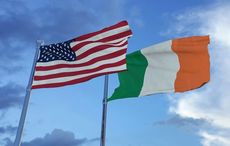How the Irish Easter Rebellion leader and the Hollywood mega-star of the 1940s are linked through one of her many marriages.
The Easter Rising and subsequent Irish revolution have always made great fodder for Hollywood. Movies such as Michael Collins, The Treaty, Beloved Enemy, The Wind That Shakes the Barley and Shake Hands with the Devil have portrayed the most exciting revolution of the 20th century in exquisite detail. And what are the odds that three of the participants—Arthur Shields, John Loder, and George Brent—would go on to have major careers in Tinsel town?
That said, not many people know that there’s an odd connection between Irish Easter Rebellion leader Padraig Pearse and Hollywood mega-star of the 1940’s Hedy Lamarr. The two names—Pearse the acetic schoolmaster and Lamarr the sexpot—should never have a connection and their names should not be used in the same sentence, but through one of Lamarr’s many marriages, there is a giant historical association.
PBS has just premiered a new documentary in their American Masters series on Lamarr, the sex siren of the 1940s. Lamarr was born in Vienna, Austria in 1914. By 1932 she had garnered worldwide attention for her daring nude scenes in a film called Ecstasy. With the coming of Hitler, Lamarr, who was Jewish, made her way to London. There she came to the attention of Louis B. Mayer, the head honcho at Metro-Goldwyn-Mayer. By coincidence, they traveled back to New York on the same ocean liner and the next thing the stunningly beautiful Lamarr knew was that she was under contract to MGM and on her way to Hollywood.
Lamarr went on to star in such hits as Algiers with Charles Boyer, Comrade X with Clark Gable, Tortilla Flat with Spencer Tracy and John Garfield, and probably her most famous role, Samson and Delilah where she starred opposite Victor Mature. But as the American Masters documentary points out Lamarr was not all beauty and no brains. In fact, during World War II, she is credited with inventing “frequency hopping” which today plays a major role in the everyday use of Wi-fi.
Husband Number Three, John Loder

Hedy Lamarr and John Loder.
But between movie-making and her intellectual pursuits, Lamarr also liked husbands, six of them in fact. Husband number three was fellow actor John Loder. Loder’s real name was John Muir Lowe. He was born in London in 1898 and while serving in the British army in World War I found his way by sheer happenstance in Dublin in 1916 in the middle of the Easter Rebellion. The reason he was in Dublin was that his father was William Henry Muir Lowe who just happened to be the British general in charge of Dublin when the rebellion broke out.
After the war Loder decided to try his hand at the acting trade and soon found his way to Hollywood. Loder appeared in many movies and TV shows from the 1930s through the 1950s. Some of the bigger pictures he played in were John Ford’s How Green Was My, Gentleman Jim starring Errol Flynn, Now Voyager with Bette Davis, Passage to Marseille with Humphrey Bogart and another John Ford vehicle, Gideon of Scotland Yard.
One of the ironies surrounding Loder was that although he was on the British side during the Easter Rebellion he went on to act with several prominent Dubliners during his sojourn in Hollywood, including Maureen O’Hara, Sara Allgood and Barry Fitzgerald in How Green Was My Valley. But the oddest twist is that his fate seemed to interact with Arthur Shields in several pictures.
Shields—younger brother of Barry Fitzgerald, the first Irish-born citizen to win an Oscar for his portrayal of lovable Father Fitzgibbons in Going My Way—fought in the GPO and surrounding environs during Easter Week. He surrendered with the rest of the rebels and found himself incarcerated with Michael Collins in the Frongoch prison camp in Wales until his release in August 1916. Shields went back to work at the Abbey Theatre and while touring the U.S. with the Abbey Players, eventually landed himself as an in-demand character actor in the 1940s, ’50s, and ’60s.
By my count, Loder appeared with Shields in three movies: the mega-hit How Green Was My Valley, Confirm or Deny starring Don Ameche where Shields plays a heroic blind teletype operator during the London Blitz, and Gentleman Jim, where the Church of Ireland Protestant Shields was playing one of his ubiquitous priest roles as Errol Flynn’s confessor, Father Burke. Shields, of course, is best remembered for playing the kindly Protestant minister, the Reverend Mr. Playfair, in John Ford’s The Quiet Man.
Read more: Remembering "The Quiet Man" star Arthur Shields who fought during the Easter Rising
Loder also had another connection to the Irish revolution via Hollywood. He starred with George Brent in 1940’s Adventure in Diamonds. Brent, known for his numerous movies with Bette Davis, was, during the War of Independence, Michael Collins doppelganger. The young Brent, only a teenager at the time, was physically mature and had the look of the Dublin Pimpernel. His job was to be seen by the British who thought they were tracking the elusive Collins. While chasing Brent, Collins would go about his business, which was the elimination of the British Secret Service in Ireland.
Read more: Actor George Brent, Michael Collins’ doppelganger, born this day in 1904
Pearse Surrenders to Loder’s Father
Which brings us back to Hedy Lamarr and Padraig Pearse. Lamarr and Loder were married for four years between 1943 and 1947. The union produced two children. The Lamarr-Pearse connection is directly through Loder.
At the end of Eastern Week, Pearse and the other leaders of the insurrection found themselves holed-up in #16 Moore Street, just down the road from the burning GPO. Pearse, along with Tom Clarke, Seán MacDiarmada, Joseph Mary Plunkett and James Connelly decided on surrender and sent nurse Elizabeth O’Farrell to make the arrangements with the British. O’Farrell returned and with Pearse in tow they went to meet General Lowe near Moore and Parnell Streets where Pearse surrendered his sword. Lowe was, according to O’Farrell, preoccupied with the whereabouts of the Countess Markievicz, who he thought was in the GPO (she was actually at the College of Surgeons in St. Stephen’s Green). General Lowe persisted in this line of questioning and an annoyed Pearse replied, “Don’t accuse me of speaking an untruth.”
In the iconic photograph of the event, on the left you can see John Loder standing next to his father, General Lowe. On the right of the picture is Pearse. The only sign of O’Farrell, hidden by Pearse’s body, are her feet, which in some versions of the photo were astonishingly airbrushed out.

Padraig Pearse Surrenders to General Lowe.
Loder was instructed by his father to accompany Pearse to prison. “My father,” said Loder, “then ordered me to take Pearse to Kilmainham Jail in a staff car. A priest drove with us and Pearse gave him his gold watch and chain and his ring. When he reached the jail gates he had not finished giving his last messages to his family, so I told the driver to keep on driving. When Pearse had finished he turned to me and said, ‘That was indeed kind of you. I’d like to give you a token of my gratitude.’ He then took off his Australian-style hat, removed the Sinn Féin badge, and handed it to me.”
It is interesting to note that Pearse knew of his importance at this historic moment and was quick to react to Loder’s act of kindness by giving him a personal souvenir. The British would shoot Pearse four days later.
So, although the connection is tenuous, there is a liaison between Hedy Lamarr and Padraig Pearse—and it goes through actor John Loder who was serendipitously in the right place at the right time, at least twice in his life.
* Dermot McEvoy is the author of the "The 13th Apostle: A Novel of a Dublin Family, Michael Collins, and the Irish Uprising and Irish Miscellany" (Skyhorse Publishing). He may be reached at [email protected]. Follow him at www.dermotmcevoy.com. Follow The 13th Apostle on Facebook here.
* Originally published in 2018.




Comments